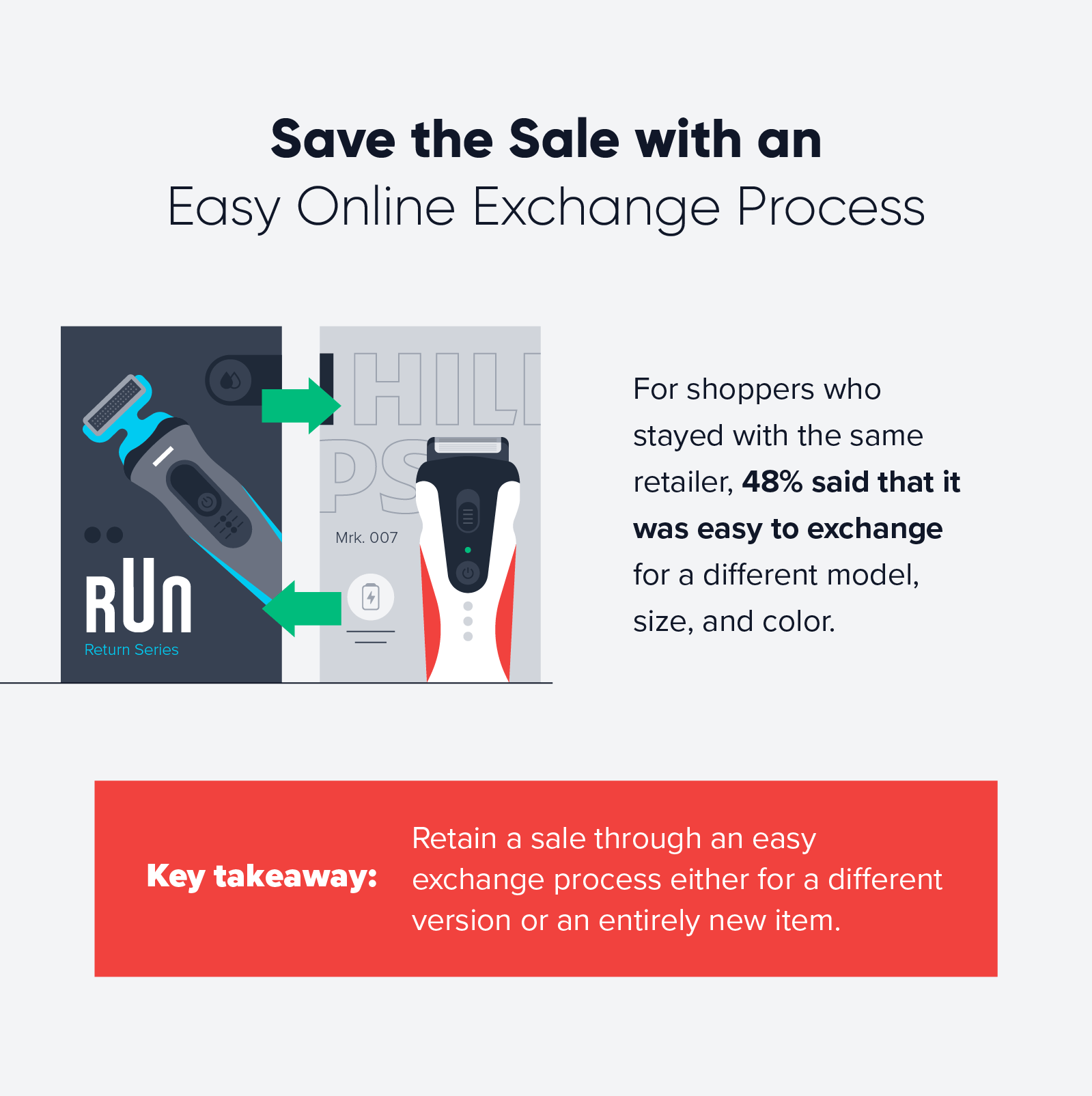In-store and online shopping were both massively disrupted in 2020, with total ecommerce sales in the U.S. hitting $792 billion*, while consumers simultaneously expressed a strong desire to try on clothes in a store again, according to a recent Klarna survey.* When you also look at the fact that returns rose to 70% YoY in 2020*, it’s worth examining how return rates for companies are affected by current and future ecommerce trends.
In this post, we’ll look closely at ecommerce return rate statistics and trends, rates by industry, reasons for returns, how rates differ by generations and countries, and the expectations that shoppers have when it comes to ecommerce return policies. Our infographic also gives a comprehensive snapshot of how the ecommerce industry has evolved.
How Is Ecommerce Return Rate Calculated?
This is a fairly simple formula to follow. To calculate an ecommerce return rate, divide the number of return items by the total number of sold items and multiply by 100. That’s your ecommerce return rate.
If your return rate is below 30%, count your lucky stars because your rate is below average. If your rate is above 30%, there is definitely some maneuvering to be done to bring it down. How this rate affects customer experience is an important factor to consider so let’s examine this further.
What Is the Average Return Rate for Ecommerce?
According to CBRE’s December 2020 forecast, the average ecommerce return rate is 30% vs. 8-10% for brick-and-mortar stores.*
Here are four other must-know stats around ecommerce returns.
- An estimated $428 billion in retail merchandise was returned in 2020. [Source: National Retail Federation and Appriss Retail]
- In January 2021, Returns Day, which is usually marked in December or January, evolved into National Returns Week due to the volume of returns expected by UPS. [Source: UPS]
- 84% of online shoppers would say goodbye to a retailer after a bad return experience. [Source: Klarna]
- The average return rate for apparel is 12.2%. [Source: National Retail Federation]

How Return Rates Affect Customer Experience
An inconvenient return experience has repercussions for businesses: 73% of online shoppers indicated that the return experience affects their choice to purchase from a retailer again.*
As it turns out, customers think about a return before they even think about a purchase. According to a UPS study, 66% of shoppers review a retailer’s return policy before they even consider a purchase.*
A high return rate doesn’t have to hurt the overall customer experience. In fact, the right return policy can even encourage repeat purchases and earn customer loyalty. By reducing the friction in the customer return journey, you can turn a potential negative experience into a positive one. Here are some ideas to remove friction from your return policy:
- Display your return policy clearly and prominently throughout the shopping experience.
- Extend your returns window past the typical 60-90 days with an expanded trial period.
- Make it easy to print return shipping labels from a home printer.
- Offer free returns with pre-paid return shipping labels.
- Accept returns by shipment as well as in-store.
- Provide home pick-up service for large and hard-to-ship items.
- Be transparent with the steps and timeline of your returns process.
- Provide an instant refund when the return package is scanned in rather than delaying until after processing.
Additionally, a customer return shouldn’t diminish Customer Lifetime Value for an ecommerce business.
Sometimes referred to as lifetime value (LTV), this is defined as the profit margin a business expects to make over the total duration of a business relationship with the average customer. Let’s delve deeper into the popular reasons for ecommerce returns.
How The World Of Ecommerce Returns Has Changed
Contactless interactions and masks weren’t the only things that changed shopping experiences in the last year. U.S. consumers spent $861 billion online in 2020, which is a 44% increase from 2019. This growth accounted for 21.3% of total retail sales in 2020.*
When it comes to ecommerce, certain trends moved quicker due to the pandemic, particularly within the return process. In the absence of having access to physical stores, the online shopping landscape evolved, but so did expectations from shoppers. Here are a few takeaways from a September 2020 report from Narvar on the state of ecommerce returns.
Retention and Returns Policy Go Hand in Hand
Here’s a new phrase that you might not be familiar with: loyalty shock. Loyalty shock describes the decrease in customer loyalty following a major socioeconomic event as customers re-prioritize their buying decisions using a new set of factors, such as budget, convenience, supply and demand, and others. This happened in a big way during the pandemic. A large number of consumers shopped with new retailers in 2020 and as a result, whether things return to ‘normal’ or not, retention is crucial. One way to master this is to ensure that your business has a good return policy.
For those who rated their last return as a ‘very easy’ return experience, almost half (46%) said it was because they were able to drop off their return at a convenient location.* An easy returns process can also affect your churn rate among existing customers that have not yet had to return a product.
Customers Will (Probably) Never Want to Pay for Return Shipping
When asked what would prevent a shopper from making a purchase in the first place, more than half (51%) said having to pay for return shipping.*
Customers will probably never want to pay for return shipping — some are even willing to pay a restocking fee to avoid this — but there’s no doubt that this can affect conversions. Offering your customers quick refunds can help with this, especially during the consideration phase, and sharing your return policy on your site and other channels is also helpful.
Save the Sale with an Easy Online Exchange Policy
Returns are an expensive exercise for retailers, but in some instances, customers are more likely to exchange an item rather than return it. And just to add another layer, the reasons why customers choose to replace an item differs whether it’s with the same retailer or a different one. One thing is clear: retailers have a great opportunity to retain the sale by offering an exchange process that is fair, convenient, and easy to follow.
4 Top Categories of Merchandise Returned
In a joint report by the National Retail Federation and Appriss Retail, it was revealed that just over $100 billion worth of online merchandise was returned in 2020.* The report also highlighted the top categories of merchandise returned and found that almost 20% of returned merchandise in 2020 in the U.S. was auto parts. Here is the percentage breakdown for the top four categories as well as online sales statistics around some of these categories.
- Online sales of auto parts and accessories are predicted to reach $21.4 billion by 2023. [Source: Digital Commerce 360]
- Online apparel and accessories retail sales are expected to reach $153.6 billion by 2024. [Source: Statista]
- Ecommerce revenue from furniture and homeware products are set to reach more than $61.2 billion in 2025. [Source: Statista]
The Environmental Price Tag of Ecommerce Returns
It turns out that there is a price tag that customers care more about than the one attached to an item. The environmental price tag of ecommerce returns is a controversial and alarming issue. According to Optoro*, in 2019, online shopping returns generated five billion tons of landfill waste and produced the same amount of carbon dioxide emissions as three million cars.
Customers are aware of this impact and are willing to make concessions to reduce their carbon footprint. To help with this, seven in ten (71%) U.S. shoppers aged 18+ said that they would journey to a physical store to return an online purchase rather than send through the mail.*
Every effort helps and retailers are aware of this, but the surge of bracketing in the last year has the potential to cancel these efforts out. For those who are not familiar with bracketing, it involves buying multiple versions of an item, trying them at home, and returning those that don’t work.
While the pandemic has greatly affected shopping behavior, it’s no surprise that other areas of our lives have changed significantly, and this has a direct hand in how we buy and return items.
For example, when Narvar polled shoppers and asked for their main reason for bracketing, 41% said it was because they either gained weight (22%) or lost weight (19%) and aren’t entirely sure what size currently fits them best.
On the other hand, almost half (48%) of those asked said that they aren’t fans of bracketing because it is wasteful. The ongoing sizing debate — sizes can differ greatly depending on the retailer — aside, one short-term solution for online retailers is to update product information and sizing advice on the website.
Ecommerce Returns Policy Best Practices: A Checklist
Whether it’s been weeks, months, or years since you analyzed and updated your ecommerce returns policy, it is always helpful to ensure that your policy is following best practices. Here are seven items to check off your list on your path to ecommerce best practices.
1. Your policy should be easy to find on your website
If it isn’t there already, a great location for your return policy is on the main menu. Your customers should never have to search for this policy. A customer knows that a return is possible and your business should respect and support that possibility.
2. Your policy should not be the result of a copy and paste job
Returns aren’t one size fits all — pun intended — so why should a return policy be a cookie cutter attempt at appeasing customers? Emphasize your commitment to customers and showcase positive and negative testimonials to show that you treat all levels of customers the same.
3. Your policy should feature keywords but not require a dictionary
Reaching your target audience and achieving SEO success are both important, but not at the expense of confusing your customers. You should use keywords but also make sure that your return policy reinforces your commitment and features helpful, recent feedback from customers.
4. Your policy should not use intimidating phrases and words
If a customer found the purchase process easy, the return process should mirror this. With that in mind, don’t get bogged down with using phrases like ‘you are required to.’ This just comes across as aggressive and could put potential customers off.
5. Your policy should be clear on what customers can expect
Does your business only offer an exchange or store credit? On average, how quickly are refunds processed? Your business should offer what is realistic and fair to your staff, resources, and timeframes. This could be a great chance to A/B test your return policy to see how your customers feel about what you currently offer.
6. Your policy should also make sense to your team members
Customer service is an important part of any business. It is therefore vital that each team member is familiar with your return policy so they can effectively assist customers, whether over the phone or online.
7. Your return policy is open to mistakes from your business
As mentioned above, there are both financial and environmental price tags attached to ecommerce returns. However, in some instances, the mistake is on the business, not the customer. When this happens, own up to your mistake and most importantly, do what it takes, within reason, to make it right with the customer.
Other important points: If you change your policy, shout about it on all your channels and be sure to honor the old policy if a product was bought prior to the change.
Happy Returns: A Business and a Case Study
Like ecommerce, technology continues to evolve and expectations from customers evolve right alongside these advancements. One company that has found a great solution to the ecommerce return problem is Happy Returns.
Happy Returns is a technology, services, and logistics platform that empowers retailers with the ability to offer their shoppers easier ways to return merchandise without having to box it up and ship it themselves.
Retailers have the option of using Happy Returns’ infrastructure to manage returns through their own retail stores, by shipping carrier, as well as through Happy Returns’ “Return Bar” locations, which are return drop-off centers that are strategically located within physical retail stores.
Return Bars can be found in national outlets such as Paper Source, Sur La Table, Cost Plus World Market, among others, and are being used by several digitally native brands, including Everlane, Rothy’s, and Parachute Home.
In May 2021, Happy Returns was acquired by PayPal and will continue to expand accessibility by offering its returns experience to online retailers and shoppers as a part of PayPal, giving smaller retailers the ability to compete against the leading return programs of Amazon and Walmart. This is definitely great news for ecommerce.
New ecommerce isn’t on the horizon. It’s already here. It’s unlikely that customers will return to the old ways of shopping and we’ll likely continue to see new and varied forms of loyalty shock into the future.
Testing and data will continue to reveal what customers want and need during the ecommerce returns process, and in the meantime, be sure to scroll down to our infographic for all the statistics and information you need for ecommerce best practices.
Shivkumar M 
Head Product Launches, Adoption, & Evangelism.Expert in cross channel marketing strategies & platforms.
Free Customer Engagement Guides
Join our newsletter for actionable tips and proven strategies to grow your business and engage your customers.















































